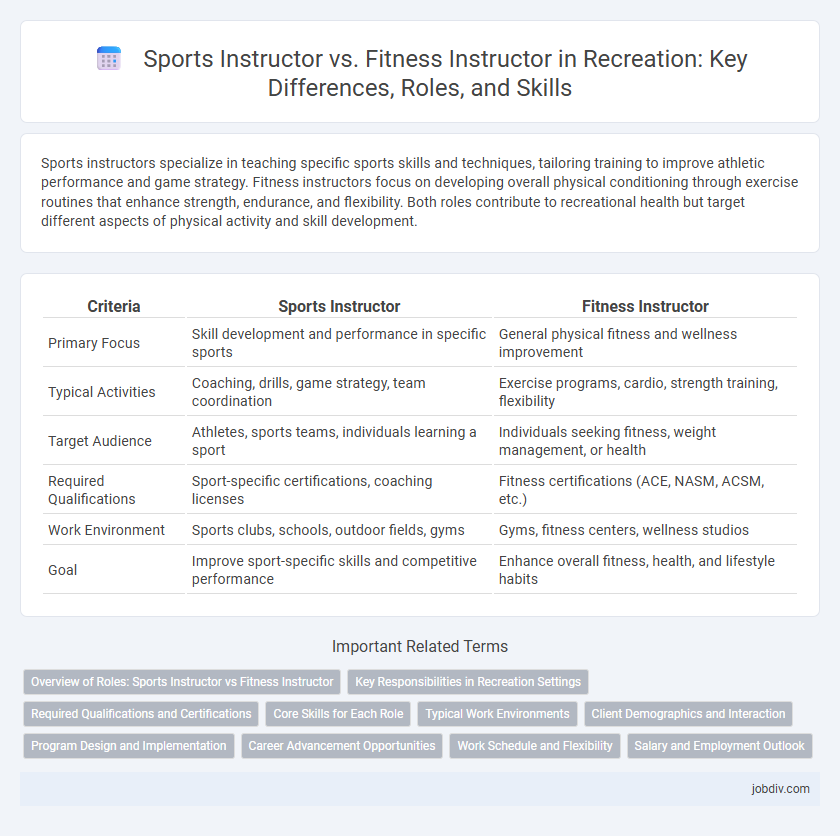Sports instructors specialize in teaching specific sports skills and techniques, tailoring training to improve athletic performance and game strategy. Fitness instructors focus on developing overall physical conditioning through exercise routines that enhance strength, endurance, and flexibility. Both roles contribute to recreational health but target different aspects of physical activity and skill development.
Table of Comparison
| Criteria | Sports Instructor | Fitness Instructor |
|---|---|---|
| Primary Focus | Skill development and performance in specific sports | General physical fitness and wellness improvement |
| Typical Activities | Coaching, drills, game strategy, team coordination | Exercise programs, cardio, strength training, flexibility |
| Target Audience | Athletes, sports teams, individuals learning a sport | Individuals seeking fitness, weight management, or health |
| Required Qualifications | Sport-specific certifications, coaching licenses | Fitness certifications (ACE, NASM, ACSM, etc.) |
| Work Environment | Sports clubs, schools, outdoor fields, gyms | Gyms, fitness centers, wellness studios |
| Goal | Improve sport-specific skills and competitive performance | Enhance overall fitness, health, and lifestyle habits |
Overview of Roles: Sports Instructor vs Fitness Instructor
Sports instructors specialize in coaching athletes to improve skills, techniques, and performance in specific sports, emphasizing sport-specific training and competitive readiness. Fitness instructors design personalized exercise programs to enhance general physical health, strength, endurance, and flexibility for a broader population. Both roles require knowledge of physiology and training principles but differ in focus, with sports instructors targeting athletic development and fitness instructors promoting overall wellness.
Key Responsibilities in Recreation Settings
Sports instructors specialize in coaching specific athletic disciplines, developing techniques, rules understanding, and competitive strategies for individuals or teams in recreation settings. Fitness instructors focus on designing personalized workout plans, conducting group exercise sessions, and promoting overall physical health and wellness. Both roles require knowledge of anatomy, motivational skills, and safety protocols to enhance participant performance and enjoyment.
Required Qualifications and Certifications
Sports Instructors typically require certifications in specific sports disciplines such as CPR, First Aid, and sport-specific coaching licenses from recognized bodies like the National Federation of State High School Associations (NFHS). Fitness Instructors often need certifications in personal training, group fitness, and exercise science from organizations like the American Council on Exercise (ACE) or National Academy of Sports Medicine (NASM). Both roles demand a solid understanding of anatomy, physiology, and client safety regulations to ensure effective and safe training sessions.
Core Skills for Each Role
Sports instructors excel in skills such as coaching techniques, sport-specific drills, and performance analysis to enhance athletic abilities. Fitness instructors focus on expertise in exercise programming, anatomy, and motivational coaching to improve overall physical health and endurance. Both roles require strong communication, leadership, and empathy to effectively guide clients and promote active lifestyles.
Typical Work Environments
Sports instructors commonly work in outdoor fields, sports complexes, and athletic clubs, focusing on team or individual sports training. Fitness instructors typically operate within gyms, health clubs, and wellness centers, guiding clients through exercise routines and personal fitness plans. Both roles may also be found in rehabilitation facilities and community centers, adapting their environments to client needs.
Client Demographics and Interaction
Sports instructors primarily work with athletes and teams, focusing on skill development, performance enhancement, and competitive training. Fitness instructors tend to serve a broader demographic, including individuals seeking general health, weight loss, or physical rehabilitation, emphasizing personalized workout plans and motivation. Interaction in sports instruction is often group-oriented with a performance goal, whereas fitness instruction typically involves one-on-one engagement tailored to individual fitness levels and objectives.
Program Design and Implementation
Sports instructors specialize in program design and implementation that targets skill development, tactical awareness, and sport-specific conditioning tailored to athletes' competitive goals. Fitness instructors focus on creating and executing personalized exercise routines aimed at improving overall physical health, strength, and endurance for diverse client populations. Both require expertise in assessing individual needs and adapting programs to optimize performance and prevent injury.
Career Advancement Opportunities
Sports instructors often progress to roles such as coaching at competitive levels or managing sports programs, leveraging specialized knowledge in specific disciplines. Fitness instructors can advance into positions like personal training, wellness coaching, or gym management, where expertise in exercise science and client motivation is essential. Both careers offer certifications and continuing education paths that enhance credentials and open doors to leadership and specialized training opportunities.
Work Schedule and Flexibility
Sports instructors typically follow structured schedules aligned with team practices, competitions, and seasonal leagues, often working evenings and weekends. Fitness instructors enjoy more flexible hours, frequently offering early morning, midday, and late evening classes to accommodate diverse client availability. Both roles require adaptability, but fitness instructors generally have greater control over their daily work schedules.
Salary and Employment Outlook
Sports instructors typically earn an average annual salary ranging from $30,000 to $50,000, with employment growth projected at 8% over the next decade, driven by increasing youth sports participation. Fitness instructors command salaries between $25,000 and $45,000, but benefit from a faster employment growth rate of 13%, fueled by rising health awareness and gym memberships. Both roles offer opportunities in diverse settings, yet fitness instructors face higher demand due to expanding wellness industries.
Sports Instructor vs Fitness Instructor Infographic

 jobdiv.com
jobdiv.com